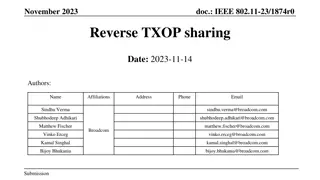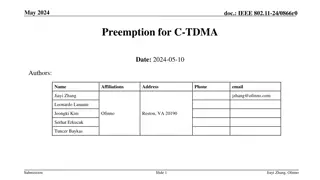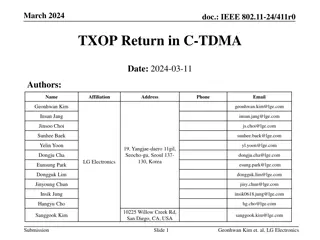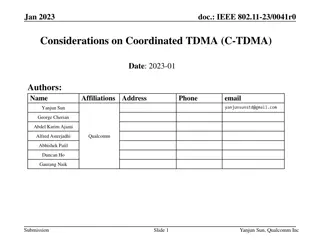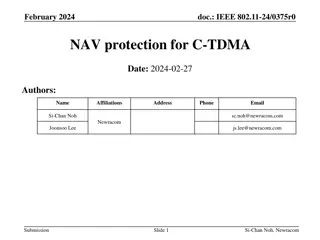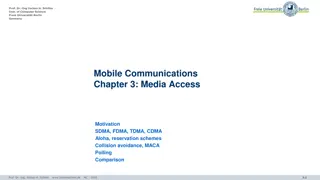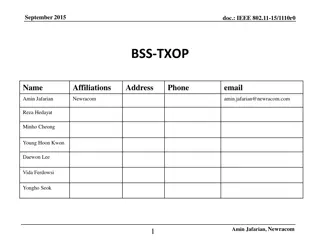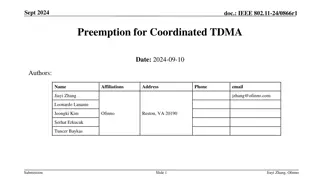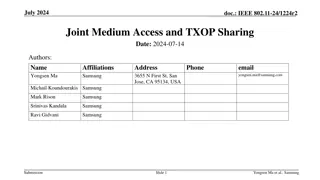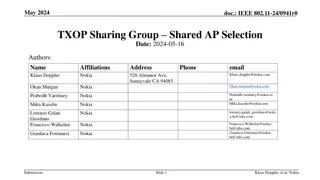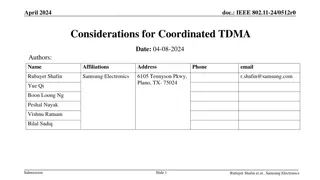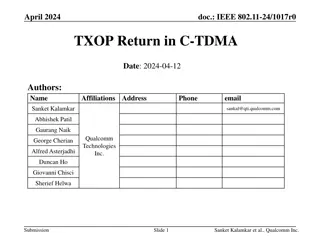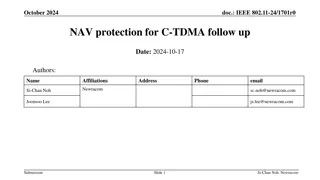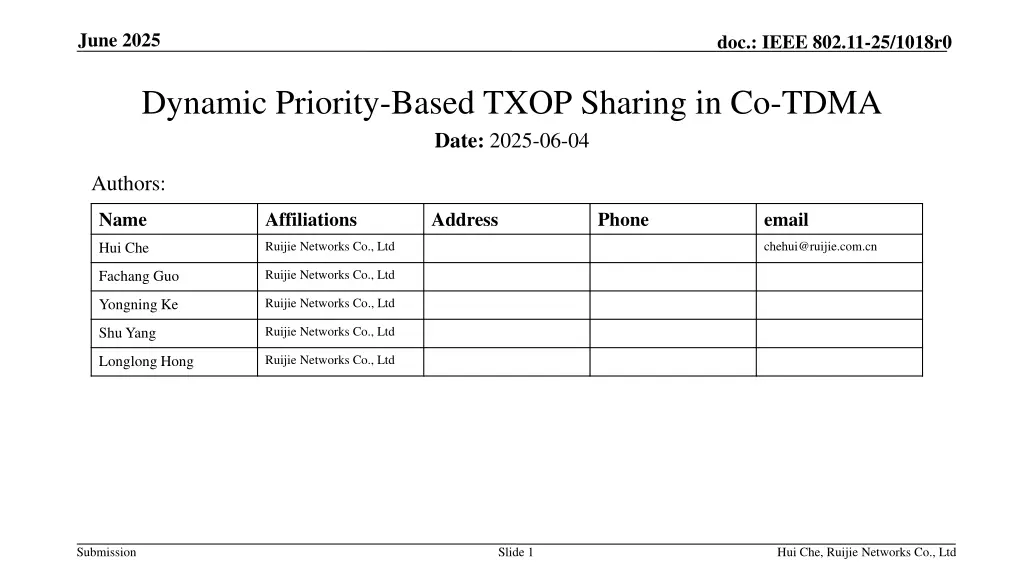
Dynamic Priority-Based TXOP Sharing in Co-TDMA Networks
Explore how IEEE 802.11 proposes dynamic urgency criteria and QoS-aware signaling for efficient TXOP sharing in Co-TDMA networks. The solution addresses issues like inefficient TXOP utilization and lack of dynamic prioritization, aiming to reduce tail latency in dense network environments.
Download Presentation

Please find below an Image/Link to download the presentation.
The content on the website is provided AS IS for your information and personal use only. It may not be sold, licensed, or shared on other websites without obtaining consent from the author. If you encounter any issues during the download, it is possible that the publisher has removed the file from their server.
You are allowed to download the files provided on this website for personal or commercial use, subject to the condition that they are used lawfully. All files are the property of their respective owners.
The content on the website is provided AS IS for your information and personal use only. It may not be sold, licensed, or shared on other websites without obtaining consent from the author.
E N D
Presentation Transcript
June 2025 doc.: IEEE 802.11-25/1018r0 Dynamic Priority-Based TXOP Sharing in Co-TDMA Date: 2025-06-04 Authors: Name Affiliations Address Phone email Ruijie Networks Co., Ltd chehui@ruijie.com.cn Hui Che Ruijie Networks Co., Ltd Fachang Guo Ruijie Networks Co., Ltd Yongning Ke Ruijie Networks Co., Ltd Shu Yang Ruijie Networks Co., Ltd Longlong Hong Submission Slide 1 Hui Che, Ruijie Networks Co., Ltd
June 2025 doc.: IEEE 802.11-25/1018r0 Abstract Background: Co-TDMA enables TXOP sharing among APs (Motion #156, #268) but lacks: Dynamic urgency criteria (CID 484/3581). QoS-aware signaling for latency-sensitive traffic (CID 624). Current polling phase only exchanges basic TID/TXOP requests (Motion #157). Proposal: Extend ICF/ICR frames with delay-tolerance signaling (e.g., Tolerance_Time in 64 s units). Prioritize APs with imminent deadlines when TIDs conflict ([1]). Key Benefit: Reduces tail latency in dense networks. Submission Slide 2 Hui Che, Ruijie Networks Co., Ltd
June 2025 doc.: IEEE 802.11-25/1018r0 Current Limitations Inefficient TXOP Utilization: Blind sharing wastes resources . Insufficient QoS Signaling/ Static Prioritization : No mechanism to report urgency (e.g., buffer expiration time). (CID 3581, [1]) scheduling Fails under identical-priority traffic. Proposed Solution: Add dynamic urgency metrics to ICR frames. Submission Slide 3 Hui Che, Ruijie Networks Co., Ltd
June 2025 doc.: IEEE 802.11-25/1018r0 Proposal Details Enhanced Signaling: ICF Frame: New field: Delay_Tolerance_Request (1 bit). Optional: Urgency_Threshold (e.g., max tolerable delay). ICR Frame: Mandatory: TID, TXOP duration (existing). Conditional (if requested): Tolerance_Time: Remaining delay budget (64 s granularity). (or) Queuing_Delay: Time-in-queue per TID. (or) Urgency_Level: Predefined tiers (0=low, 3=critical). Scheduling Algorithm: Prefer higher TID. If TIDs equal Select AP with smallest Tolerance_Time. Required Changes: Define ICR fields for urgency signaling. Add TXOP_RETURN_PRIORITY flag to protect high-urgency transmissions. CID 3581 Resolution: Adopt 64 s granularity (same to DUO) for delay reporting. Submission Slide 4 Hui Che, Ruijie Networks Co., Ltd
June 2025 doc.: IEEE 802.11-25/1018r0 Why This Works? The proposed delay-tolerance feedback (e.g., Tolerance_Time in ICR frames) mitigates tail latency by: (a) Prioritizing Near-Deadline Traffic Example: AP1 has a VI (Video) flow with Tolerance_Time = 200 s. AP2 has a VI flow with Tolerance_Time = 2ms. Action: Sharing AP allocates the TXOP to AP1 first, preventing packet drops. Result: Worst-case delays for urgent traffic are slashed. (b) Avoiding "Blind" TXOP Sharing Without urgency signaling, a sharing AP might: Allocate resources to an AP with non-urgent traffic (e.g., bulk data). Let time-critical packets miss deadlines long-tail delays. With urgency signaling: TXOPs are selectively shared with APs about to violate deadlines Submission Slide 5 Hui Che, Ruijie Networks Co., Ltd
June 2025 doc.: IEEE 802.11-25/1018r0 Expected Benefits Metric TID-Based (Current) Urgency-Aware (Proposal) Deadline Awareness No Yes (Tolerance_Time) Tail Latency Control Random Predictable Tail Latency Reduction: Prioritizes near-deadline traffic (CID 3581). Overhead Reduction: Avoids sharing with non-urgent APs ( [1]). Fairness: Aligns with Motion #274 by balancing urgency and starvation prevention. Submission Slide 6 Hui Che, Ruijie Networks Co., Ltd
June 2025 doc.: IEEE 802.11-25/1018r0 Conclusion This proposal improves Co-TDMA s efficiency in dense networks by dynamically prioritizing urgent traffic, reducing tail latency, and aligning with industry motions (e.g., #484, 3581) Submission Slide 7 Hui Che, Ruijie Networks Co., Ltd
June 2025 doc.: IEEE 802.11-25/1018r0 References [1] Sanket Kalamkar, IEEE 802.11-24/1016r3, C-TDMA follow-up: Additional details on framing sequence. [2] Motions #156, 268, 157, 160, 274, 277, 329. [3]IEEE 802.11bn Draft 0.1. [4] CID 484, 624, 3581. Submission Slide 8 Hui Che, Ruijie Networks Co., Ltd
June 2025 doc.: IEEE 802.11-25/1018r0 Comments CID 484 If there are more than one AP that a Co-TDMA sharing AP can share a time porition of an obtained TXOP with, does it share it with all of them or some of them? How does it chose the APs with whom it can share a portion of the TXOP? E.g., if there are three APs with whom it can share a porition of the TXOP but one of them needs it urgently because some of its buffered data can expire soon, how does the scheme ensure that the porition of TXOP is shared with the AP that needs the resource urgently? Proposed Change Spec should provide a procedure by which information necessary to evaluate urgency criteria can be shared exchanged with the Co-TDMA sharing AP. This can help the Co-TDMA sharing AP to select the AP that needs the resource the most. CID 624: In the current document, the information exchange between the sharing AP and the shared AP is very limited in the polling phase. Since Co-TDMA is one of the technologies that can guarantee minimum latency performance in a dense OBSS environment, related information must be exchanged in the polling phase Proposed Change Define signaling to exchange QoS info (traffic, etc.) CID 3581: Please see comment 6 in relation to CoTDMA. Unlike 802,11ax/802.11be AP schedulers that can directly leverage BSRP responses (i.e. Qsize), the sharing AP is unliikely to be able to formualte a shared AP order and time allocation for a shared AP with just this information. This is especially true when CoTDMA benefits to many enviironments will be delay CDF tail reduction as opposed to throughput hence the 'signaling details' should accomodate this delay-reduction usage which e.g.may be implemented via ordering and time allocation of the shared APs to meet the APs scheduling deadline requirements, Proposed Change Add the imminence / deadline / excess delay in e.g. 250us units to the CoTDMA polling phase. The shared AP could report one (minimum) or multiple such elements oer TID/AC allowing the sharing AP to schedule accordingly. Submission Slide 9 Hui Che, Ruijie Networks Co., Ltd

